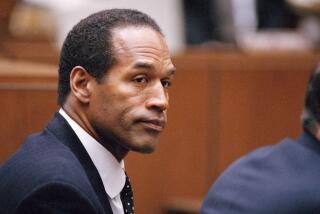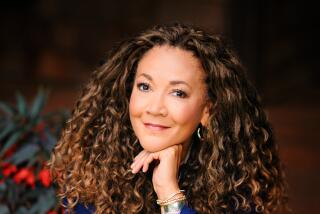Divided We Stand : Boston. South Carolina. Oklahoma City. The misplaced finger of blame in each case points up the delicate nature of race relations.
- Share via
How easily we rush to judgment.
First came the point-blank murder of a young, white Boston woman, eight months pregnant, onher way home from a birthing class with her husband. What thug from which ghetto did it?
Then there was the South Carolina mother who cried into national microphones that a black man in a red jogging suit had stolen her car and her babies. We swallowed that one too.
And then last week, when terrorists struck in Oklahoma City, the nation’s rage immediately focused on those wild-eyed, bomb-throwing Muslims. And we were wrong once again.
It’s bad enough to accuse the wrong person of a monstrous deed. But when a false accusation casts suspicion on an entire ethnic group, it’s an ugly reminder of just how thin our illusion of brotherhood and mutual respect is, just how delicate the balance is. When the mistake is discovered, the accused group’s relief is quickly followed by anger.
“I think bias creates the environment of hostility and ripens the situation so that scapegoating is possible,” says Salam Al-Marayati, director of the Muslim Public Affairs Council in Los Angeles. “Every Muslim becomes a potential terrorist. Every African American is a potential gang banger. Every Latino is a potential illegal immigrant. It’s bias that is used against us.”
In Oklahoma, some people assumed Middle Eastern saboteurs had exploded the bomb outside the Alfred P. Murrah Federal Building in part because Muslims were convicted of the 1993 bombing of the World Trade Center in New York.
“There were political opportunists who used the Oklahoma City bombing incident to grandstand and to instill fear and hate in the American public,” Al-Marayati says. Epithets and hate were immediately directed at Muslims.
“The perception is that the religion advocates violence,” he says, but Islam “teaches love and human kindness, not hate.”
He says that when it was initially believed that Muslims were suspected of the bombing, thoughts of “the Inquisition, Japanese internment, McCarthyism” raced through his mind. “‘But I also was praying to God to open the doors of reconciliation to give us an opportunity to help this country and this world become a safer and a more harmonious place to live.”
Racism--destructive, divisive, dehumanizing--contaminates the American psyche, says Manuel Guillot, vice president of MALDEF, the Mexican-American Legal Defense and Educational Fund.
“Racism is not against an individual, it’s against a class of people because of the color of their skin or their nationality,” he says.
“So when someone commits a crime who is not a member of a minority group, it doesn’t become a racist issue because they look at the individual who committed the act, in terms of good and evil human beings in this world. But when (a group) has historically been a victim of racism, then any member of that group who commits a crime automatically represents the entire class.”
“Historically, this country has had a tendency to scapegoat and stereotype people. In fact, demonize people based on their ethnicity and race,” says Joe Hicks, executive director of the Southern Christian Leadership Conference of Greater Los Angeles and executive vice president of the Martin Luther King Legacy Assn.
People of color often “become handy foils for a variety of situations in the nation,” he says.
It must have seemed that way to Charles Stuart, the husband in that Boston murder in 1989. Only his dramatic suicide revealed the truth: There was no black assailant. Stuart had killed his wife.
Also to Susan Smith, who later confessed to drowning her children and inventing the heartless black kidnaper as a cover-up.
To much of the nation, both tales seemed easy to believe.
Hicks says this attitude has been created “by a growing shift in the country by people who have scapegoated ethnic populations,” and it can “beget national hysteria.”
*
Ramon A. Gutierrez, director of the Center for the Study of Race and Ethnicity at the University of California at San Diego, says the rush to bash outsiders--and to blame them for the blood of innocents--”teaches us a lot about the dynamics of racism.”
“In general, the sickness of one reflects the malady of the whole group,” says Gutierrez, a history professor and founding chair of the Ethnic Studies Department.
He says that in the Stuart and Smith cases, as well as in the case of Tawana Brawley, the black New York teen-ager who falsely charged that a gang of whites abducted and raped her in 1987, the accusers “projected their fantasies about the heinous and abominable crimes they had committed on a racial enemy--and that really says a lot about ourselves and about our own suspicions and fears.”
Nell Painter, a history professor who also works in the Afro-American Studies Program at Princeton University, says that since last fall she has noticed an increase in “thinly veiled racial hatred” on talk radio and on television talk shows.
“This is a very hateful time in America. I have been expecting a revival of lynching, a revival of racial violence”--the kind of violence that “has Old South fingerprints all over it,” she says.
Patricia A. Turner, author and associate professor of African American Studies at the University of California, Davis, agrees.
“There were an awful lot of African Americans working in that building. And some will interpret this as racial violence against us,” says the author of “Ceramic Uncles and Celluloid Mammies: Black Images and Their Influence on Culture” and “I Heard It Through the Grapevine: Rumor in African American Culture.”
She says some of her first recollections as a child during the civil rights movement are “of my parents praying and willing that the race of an assailant on television news be other than black.”
Today, Turner finds herself feeling the same way.
“When I hear a news report that implicates an African American, intellectually I know I have nothing to do with that. I follow all the rules. I’m law-abiding. I stop at stop signs. But I can’t stop an emotional response of ‘Please, don’t let this person be black.’
“I don’t think that white Americans have that response when they heard about Susan Smith or Charles Stuart,” says Turner, who was teaching African American studies at the University of Massachusetts in Boston during the Stuart ordeal. Black students, she says, were stopped and searched illegally. At their restaurant jobs, patrons requested white waiters and waitresses. A student working as an airport porter told that her white people didn’t want him handling their luggage.
“White people aren’t conditioned to perceive their world as always being on trial,” she says.
*
How can America immunize itself against fire-breathing rhetoric, racial bashing and exploiting ethnicity or religion?
“The fundamental principle that needs to be dealt with is how can we achieve unity and diversity? How is it that we can see our diversity in America as a strength as opposed to something that weakens us?” asks John Woodall, a psychiatrist and faculty member at Harvard University’s School of Medicine. Woodall, a United Nations consultant, is an authority in the field of conflict resolution and has taught courses on healing racism in America.
“The disease of racism is this notion carried by the white population that there is an inherent superiority in people who are white, which brings with it the assumption that we are the dispensers of favors. It’s these assumptions that color the social debate and these assumptions are wrong.
“And it’s because of one’s presumed superiority that that person can see someone else of another race or ethnicity as a bad guy.”
Woodall adds that racism in America has an international implication. But it is America that can provide the standard “of true inter-ethnic cooperation” for the world.
“Americans have a special destiny in dealing with this issue: We can be a perfect model for the planet. We either head that way or continue to pay the price.”
More to Read
Sign up for Essential California
The most important California stories and recommendations in your inbox every morning.
You may occasionally receive promotional content from the Los Angeles Times.









